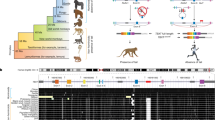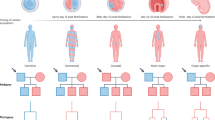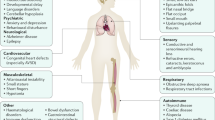Abstract
In some cases of infants with apparently isolated single-suture synostosis, an underlying variant can be found. We aimed to determine the molecular substratum in isolated sagittal and metopic craniosynostosis. To this end, we included all infants who presented isolated midline synostosis (sagittal or metopic) and had undergone surgery at the craniosynostosis national reference center of Lyon University Hospital. All infants were examined by a multidisciplinary team including neurosurgeons, clinical geneticists and neuropsychologist. Among 101 infants tested, 13 carried a total of 13 variants; that is, 12.9% of the infants carried a variant in genes known to be involved in craniosynostosis. Seven infants carried SMAD6 variants, 2 in FGFR2, 1 in TWIST1, one in FREM1, one in ALX4 and one in TCF12. All variants were detected at the heterozygous level in genes associated with autosomal dominant craniosynostosis. Also, neurodevelopmental testing showed especially delayed acquisition of language in children with than without variants in SMAD6. In conclusion, a high percentage of young children with isolated midline craniosynostosis, especially in isolated trigonocephaly, carried SMAD6 variants. The interpretation of the pathogenicity of the genes must take into account incomplete penetrance, usually observed in craniosynostosis. Our results highlight the interest of molecular analysis in the context of isolated sagittal and/or metopic craniosynostosis to enhance an understanding of the pathophysiology of midline craniosynostosis.
This is a preview of subscription content, access via your institution
Access options
Subscribe to this journal
Receive 12 print issues and online access
$259.00 per year
only $21.58 per issue
Buy this article
- Purchase on Springer Link
- Instant access to full article PDF
Prices may be subject to local taxes which are calculated during checkout


Similar content being viewed by others
Data availability
The data that support the findings of this study are available on request from the corresponding author. The data are not publicly available due to privacy or ethical restrictions.
References
Wilkie AOM, Johnson D, Wall SA. Clinical genetics of craniosynostosis. Curr Opin Pediatr. 2017;29:622–8.
Cornelissen M, Ottelander B, den, Rizopoulos D, van der Hulst R, Mink van der Molen A, van der Horst C, et al. Increase of prevalence of craniosynostosis. J Cranio-Maxillofac Surg. 2016;44:1273–9.
Di Rocco F, Arnaud E, Renier D. Evolution in the frequency of nonsyndromic craniosynostosis: clinical article. J Neurosurg: Pediatr. 2009;4:21–5.
Mocquard C, Aillet S, Riffaud L. Recent advances in trigonocephaly. Neurochirurgie. 2019;65:246–51.
Vinchon M, Guerreschi P, Karnoub MA, Wolber A. Synostosis of the lambdoid suture: a spectrum. Child’s Nerv Syst. 2021;37:1991–2000.
Calpena E, Cuellar A, Bala K, Swagemakers SMA, Koelling N, McGowan SJ, et al. SMAD6 variants in craniosynostosis: genotype and phenotype evaluation. Genet Med. 2020;22:1498–506.
Timberlake AT, Choi J, Zaidi S, Lu Q, Nelson-Williams C, Brooks ED, et al. Two locus inheritance of non-syndromic midline craniosynostosis via rare SMAD6 and common BMP2 alleles. Elife. 2016;5:e20125.
McGillivray G, Savarirayan R, Cox TC, Stojkoski C, McNeil R, Bankier A, et al. Familial scaphocephaly syndrome caused by a novel mutation in the FGFR2 tyrosine kinase domain. J Med Genet. 2005;42:656–62.
Sharma VP, Wall SA, Lord H, Lester T, Wilkie AOM. Atypical crouzon syndrome with a novel Cys62Arg mutation in FGFR2 presenting with sagittal synostosis. Cleft Palate-Cranio-fac J. 2012;49:373–7.
Yilmaz E, Mihci E, Guzel Nur B, Alper OM. A novel AXIN2 gene mutation in sagittal synostosis. Am J Med Genet Part A. 2018;176:1976–80.
Foo R, Guo Y, McDonald-Mcginn DM, Zackai EH, Whitaker LA, Bartlett SP. The natural history of patients treated for TWIST1-confirmed Saethre-Chotzen syndrome. Plast Reconstr Surg. 2009;124:2085–95.
Vissers LELM, Cox TC, Maga AM, Short KM, Wiradjaja F, Janssen IM, et al. Heterozygous mutations of FREM1 are associated with an increased risk of isolated metopic craniosynostosis in humans and mice. PLoS Genet. 2011;7:e1002278.
Timberlake AT, Persing JA. Genetics of nonsyndromic craniosynostosis. Plast Reconstr Surg. 2018;141:1508–16.
Duyme M, Zorman M, Tervo R, Capron C. French norms and validation of the Child Development Inventory (CDI): Inventaire du Développement de l’Enfant (IDE). Clin Pediatr. 2011;50:636–47.
Yang Y, Zheng Y, Li W, Li L, Tu M, Zhao L, et al. SMAD6 is frequently mutated in nonsyndromic radioulnar synostosis. Genet Med. 2019;21:2577–85.
Gillis E, Kumar AA, Luyckx I, Preuss C, Cannaerts E, van de Beek G, et al. Candidate gene resequencing in a large bicuspid aortic valve-associated thoracic aortic aneurysm cohort: SMAD6 as an important contributor. Front Physiol. 2017;8:400.
Roscioli Tony. Genotype and clinical care correlations in craniosynostosis: findings from a cohort of 630 Australian and New Zealand patients. Am J Med Genet Part C: Semin Med Genet. 2013;163:259–70.
Lapunzina P, Fernández A, Sánchez Romero JM, Delicado A, De Pipaon MS, Pajares IL, et al. A novel insertion in the FGFR2 gene in a patient with Crouzon phenotype and sacrococcygeal tail. Birth Defects Res Part A - Clin Mol Teratol. 2005;73:61–4.
Marie PJ, Kaabeche K, Guenou H. Roles of FGFR2 and twist in human craniosynostosis: insights from genetic mutations in cranial osteoblasts. Front Oral Biol. 2008;12:144–59.
Funato N, Twigg SRF, Higashihori N, Ohyama K, Wall SA, Wilkie AOM, et al. Functional analysis of natural mutations in two TWIST protein motifs. Hum Mutat. 2005;25:550–6.
Altunoglu U, Satkin B, Uyguner ZO, Kayserili H. Mild nasal clefting may be predictive for ALX4 heterozygotes. Am J Med Genet Part A. 2014;164:2054–8.
Mavrogiannis LA, Taylor IB, Davies SJ, Ramos FJ, Olivares JL, Wilkie AOM. Enlarged parietal foramina caused by mutations in the homeobox genes ALX4 and MSX2: from genotype to phenotype. Eur J Hum Genet. 2006;14:151–8.
Yagnik G, Ghuman A, Kim S, Stevens CG, Kimonis V, Stoler J, et al. ALX4 gain-of-function mutations in nonsyndromic craniosynostosis. Hum Mutat. 2012;33:1626–9.
Fonteles CS, Finnell RH, Lei Y, Zurita-Jimenez ME, Monteiro AJ, George TM, et al. De novo ALX4 variant detected in child with non-syndromic craniosynostosis. Braz J Med Biol Res. 2021;54:11396.
Bertola DR, Rodrigues MG, Quaio CRDC, Kim CA, Passos-Bueno MR. Vertical transmission of a frontonasal phenotype caused by a novel ALX4 mutation. Am J Med Genet Part A. 2013;161:600–4.
Loebel DAF, O’Rourke MP, Steiner KA, Banyer J, Tam PPL. Isolation of differentially expressed genes from wild-type and Twist mutant mouse limb buds. Genesis. 2002;33:103–13.
García-Sanz P, Fernández-Pérez A, Vallejo M. Differential configurations involving binding of USF transcription factors and Twist1 regulate Alx3 promoter activity in mesenchymal and pancreatic cells. Biochem J. 2013;450:199–208.
Tønne E, Due-Tønnessen BJ, Wiig U, Stadheim BF, Meling TR, Helseth E, et al. Epidemiology of craniosynostosis in Norway. J Neurosurg: Pediatr. 2020;26:68–75.
Timberlake AT, Wu R, Nelson-Williams C, Furey CG, Hildebrand KI, Elton SW, et al. Co-occurrence of frameshift mutations in SMAD6 and TCF12 in a child with complex craniosynostosis. Hum Genome Var. 2018;5:14.
Yilmaz E, Mihci E, Nur B, Alper ÖM, Taçoy Ş. Recent advances in craniosynostosis. Pediatr Neurol. 2019;99:7–15.
Wu RT, Timberlake AT, Abraham PF, Gabrick KS, Lu X, Peck CJ, et al. SMAD6 genotype predicts neurodevelopment in nonsyndromic craniosynostosis. Plast Reconstr Surg. 2020;145:117e–25e.
Dawson AJ, Hovanes K, Liu J, Marles S, Greenberg C, Mhanni A, et al. Heterozygous intragenic deletions of FREM1 are not associated with trigonocephaly. Clin Dysmorphol. 2021;30:83–8.
Seto ML, Hing AV, Chang J, Hu M, Kapp-Simon KA, Patel PK, et al. Isolated sagittal and coronal craniosynostosis associated with TWIST box mutations. Am J Med Genet Part A. 2007;143:678–86.
Antonopoulou I, Mavrogiannis LA, Wilkie AOM, Morriss-Kay GM. Alx4 and Msx2 play phenotypically similar and additive roles in skull vault differentiation. J Anat. 2004;204:487–99.
Sewda A, White SR, Erazo M, Hao K, García-Fructuoso G, Fernández-Rodriguez I, et al. Nonsyndromic craniosynostosis: novel coding variants. Pediatr Res. 2019;85:463–8.
Yoon JG, Hahn HM, Choi S, Kim SJ, Aum S, Yu JW, et al. Molecular diagnosis of craniosynostosis using targeted next-generation sequencing. Neurosurgery. 2020;87:294–302.
Lee E, Le T, Zhu Y, Elakis G, Turner A, Lo W, et al. A craniosynostosis massively parallel sequencing panel study in 309 Australian and New Zealand patients: findings and recommendations. Genet Med. 2018;20:1061–8.
Zhang J, Kurgan L. Review and comparative assessment of sequence-based predictors of protein-binding residues. Brief Bioinform. 2018;19:821–37.
Fan X, Waardenberg AJ, Demuth M, Osteil P, Sun JQJ, Loebel DAF, et al. TWIST1 homodimers and heterodimers orchestrate lineage-specific differentiation. Mol Cell Biol. 2020;40:e00663–19.
Acknowledgements
We thank Ms Stephanie Serre for her help in the preparation of the manuscript. We are grateful to the patients and their families who participated to this study.
Funding
No specific funding.
Author information
Authors and Affiliations
Contributions
FDR: conception and design, acquisition of data (AD), analysis and interpretation of data and writing original draft. MR: AD, analysis and interpretation of data, manuscript revising, IV: AD, analysis and interpretation of data, manuscript revising. AS: AD, NC: AD, PAB: AD, JCP: AD, PM: AD, CM: AD, MV: AD, SG: AD, analysis and interpretation of data,manuscript revising, CC: AD, conception and design, analysis and interpretation of data and writing original draft.
Corresponding author
Ethics declarations
Competing interests
The authors declare no competing interests.
Ethical approval
The molecular analysis was approved by the French ethics committee (no. IRB00011687; College de neurochirurgie IRB #1: 2022/05) and was performed after parents gave signed informed consent for genetic testing.
Additional information
Publisher’s note Springer Nature remains neutral with regard to jurisdictional claims in published maps and institutional affiliations.
Supplementary information
Rights and permissions
Springer Nature or its licensor (e.g. a society or other partner) holds exclusive rights to this article under a publishing agreement with the author(s) or other rightsholder(s); author self-archiving of the accepted manuscript version of this article is solely governed by the terms of such publishing agreement and applicable law.
About this article
Cite this article
Di Rocco, F., Rossi, M., Verlut, I. et al. Clinical interest of molecular study in cases of isolated midline craniosynostosis. Eur J Hum Genet 31, 621–628 (2023). https://doi.org/10.1038/s41431-023-01295-y
Received:
Revised:
Accepted:
Published:
Issue Date:
DOI: https://doi.org/10.1038/s41431-023-01295-y
This article is cited by
-
2023 in the European Journal of Human Genetics
European Journal of Human Genetics (2024)
-
Two novel mutations within FREM1 gene in patients with bifid nose
BMC Pediatrics (2023)
-
SMAD6 variants in nonsyndromic craniosynostosis
European Journal of Human Genetics (2023)
-
The complex genomics of single gene disorders
European Journal of Human Genetics (2023)
-
Technical evolution of pediatric neurosurgery: craniosynostosis from 1972 to 2023 and beyond
Child's Nervous System (2023)



